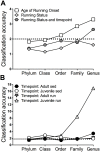Exercise is More Effective at Altering Gut Microbial Composition and Producing Stable Changes in Lean Mass in Juvenile versus Adult Male F344 Rats
- PMID: 26016739
- PMCID: PMC4446322
- DOI: 10.1371/journal.pone.0125889
Exercise is More Effective at Altering Gut Microbial Composition and Producing Stable Changes in Lean Mass in Juvenile versus Adult Male F344 Rats
Abstract
The mammalian intestine harbors a complex microbial ecosystem that influences many aspects of host physiology. Exposure to specific microbes early in development affects host metabolism, immune function, and behavior across the lifespan. Just as the physiology of the developing organism undergoes a period of plasticity, the developing microbial ecosystem is characterized by instability and may also be more sensitive to change. Early life thus presents a window of opportunity for manipulations that produce adaptive changes in microbial composition. Recent insights have revealed that increasing physical activity can increase the abundance of beneficial microbial species. We therefore investigated whether six weeks of wheel running initiated in the juvenile period (postnatal day 24) would produce more robust and stable changes in microbial communities versus exercise initiated in adulthood (postnatal day 70) in male F344 rats. 16S rRNA gene sequencing was used to characterize the microbial composition of juvenile versus adult runners and their sedentary counterparts across multiple time points during exercise and following exercise cessation. Alpha diversity measures revealed that the microbial communities of young runners were less even and diverse, a community structure that reflects volatility and malleability. Juvenile onset exercise altered several phyla and, notably, increased Bacteroidetes and decreased Firmicutes, a configuration associated with leanness. At the genus level of taxonomy, exercise altered more genera in juveniles than in the adults and produced patterns associated with adaptive metabolic consequences. Given the potential of these changes to contribute to a lean phenotype, we examined body composition in juvenile versus adult runners. Interestingly, exercise produced persistent increases in lean body mass in juvenile but not adult runners. Taken together, these results indicate that the impact of exercise on gut microbiota composition as well as body composition may depend on the developmental stage during which exercise is initiated.
Conflict of interest statement
Figures






Similar articles
-
Physical Activity Differentially Affects the Cecal Microbiota of Ovariectomized Female Rats Selectively Bred for High and Low Aerobic Capacity.PLoS One. 2015 Aug 24;10(8):e0136150. doi: 10.1371/journal.pone.0136150. eCollection 2015. PLoS One. 2015. PMID: 26301712 Free PMC article.
-
Age-Related Differences in the Luminal and Mucosa-Associated Gut Microbiome of Broiler Chickens and Shifts Associated with Campylobacter jejuni Infection.Front Cell Infect Microbiol. 2016 Nov 22;6:154. doi: 10.3389/fcimb.2016.00154. eCollection 2016. Front Cell Infect Microbiol. 2016. PMID: 27921008 Free PMC article.
-
The dynamic distribution of porcine microbiota across different ages and gastrointestinal tract segments.PLoS One. 2015 Feb 17;10(2):e0117441. doi: 10.1371/journal.pone.0117441. eCollection 2015. PLoS One. 2015. PMID: 25688558 Free PMC article.
-
Structure and functions of the gut microbiome.Endocr Metab Immune Disord Drug Targets. 2014;14(4):290-9. doi: 10.2174/1871530314666140714120744. Endocr Metab Immune Disord Drug Targets. 2014. PMID: 25022563 Review.
-
Impact of Physical Exercise on Gut Microbiome, Inflammation, and the Pathobiology of Metabolic Disorders.Rev Diabet Stud. 2019;15:35-48. doi: 10.1900/RDS.2019.15.35. Epub 2019 Aug 4. Rev Diabet Stud. 2019. PMID: 31380886 Free PMC article. Review.
Cited by
-
Effect of moderate aerobic exercises on symptoms of functional dyspepsia.Indian J Gastroenterol. 2021 Apr;40(2):189-197. doi: 10.1007/s12664-021-01174-8. Epub 2021 May 26. Indian J Gastroenterol. 2021. PMID: 34037955 Clinical Trial.
-
Diet, physical activity and screen time but not body mass index are associated with the gut microbiome of a diverse cohort of college students living in university housing: a cross-sectional study.BMC Microbiol. 2018 Dec 12;18(1):210. doi: 10.1186/s12866-018-1362-x. BMC Microbiol. 2018. PMID: 30541450 Free PMC article.
-
The Emerging Role of the Aging Process and Exercise Training on the Crosstalk between Gut Microbiota and Telomere Length.Int J Environ Res Public Health. 2022 Jun 25;19(13):7810. doi: 10.3390/ijerph19137810. Int J Environ Res Public Health. 2022. PMID: 35805470 Free PMC article. Review.
-
The Effects of Physical Activity on the Gut Microbiota and the Gut-Brain Axis in Preclinical and Human Models: A Narrative Review.Nutrients. 2022 Aug 11;14(16):3293. doi: 10.3390/nu14163293. Nutrients. 2022. PMID: 36014798 Free PMC article. Review.
-
Exploration of the Relationship Between Gut Microbiota and Polycystic Ovary Syndrome (PCOS): a Review.Geburtshilfe Frauenheilkd. 2020 Feb;80(2):161-171. doi: 10.1055/a-1081-2036. Epub 2020 Feb 21. Geburtshilfe Frauenheilkd. 2020. PMID: 32109968 Free PMC article.
References
-
- Hill MJ. Intestinal flora and endogenous vitamin synthesis. Eur J Cancer Prev. 1997;6 Suppl 1: S43–45. - PubMed
-
- Conly JM, Stein K, Worobetz L, Rutledge-Harding S. The contribution of vitamin K2 (menaquinones) produced by the intestinal microflora to human nutritional requirements for vitamin K. Am J Gastroenterol. 1994;89: 915–923. - PubMed
Publication types
MeSH terms
Substances
Grants and funding
LinkOut - more resources
Full Text Sources
Other Literature Sources

